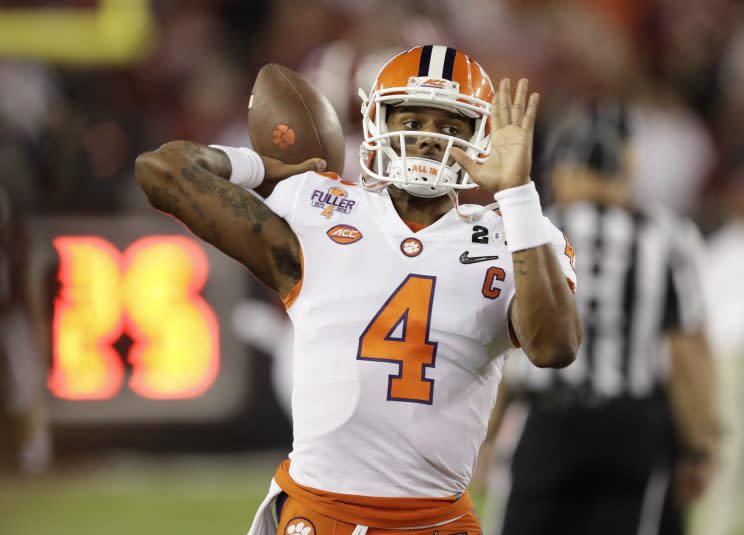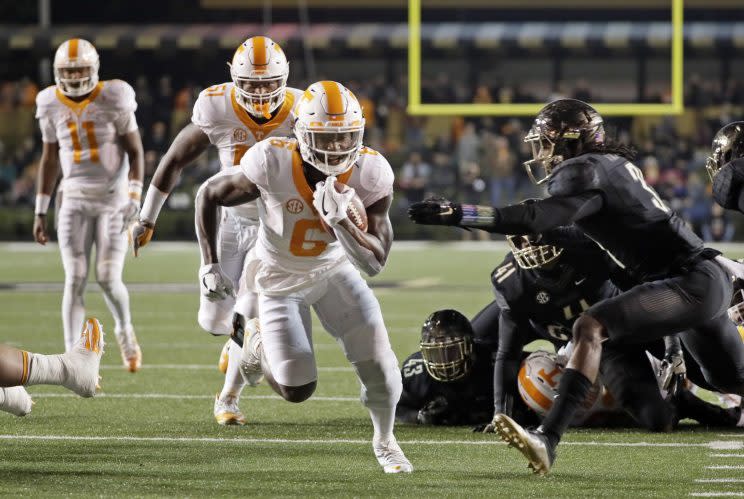Browns in position of power at NFL scouting combine, but will weak QB class limit Cleveland?
INDIANAPOLIS – For all intents and purposes, the Cleveland Browns will be setting the table for much of the NFL draft. As such, the Browns’ agenda at the NFL’s annual scouting combine will be of particular interest in Indianapolis this week.
Not just because Cleveland has two first-round picks (Nos. 1 and 12) and will kick the draft off on April 27. But also because the Browns have five of the top 65 selections and 11 picks overall, a haul that includes compensatory selections. This means that Cleveland is once again expected to be open for business on the trade market, fielding offers for the No. 1 overall pick and shoring up a draft board that can add foundational pieces to a roster that finished 1-15 last season.

With a weak quarterback class in play, it’s unlikely another team will mount a massive campaign to move up to the top pick like the Los Angeles Rams did last year. But the Browns have enough needs that adding more assets in a move will be a consideration. And not simply from the top pick, either. Moving out of No. 12 may be more inviting if the Browns find a quarterback worthy of selecting later in the draft. Or if the team isn’t thrilled with the 2017 quarterback class and sets its sights on the New England Patriots’ Jimmy Garoppolo.
Either way, the ideal scenario for the Browns is crystal clear: Cleveland’s best-case outcome is finding a cornerstone defensive end at No. 1 (like Texas A&M’s Myles Garrett) and pairing him with an anchor quarterback at No. 12 (drafting North Carolina’s Mitch Trubisky, Notre Dame’s DeShone Kizer or Clemson’s Deshaun Watson … or trading the pick for Garoppolo). These needs and Cleveland’s first-round placement make the franchise the table-setter in this draft as many will be angling for similar assets. And that reality makes this combine more important for the Browns than arguably another NFL team.
Some of the other intriguing storylines of this week …
The quarterback class
This QB class had the potential to be the worst invited to the combine in 20 years, one NFL evaluator told Yahoo Sports in mid-December. That harsh assessment included the 2013 draft group, which has proven to be the height of NFL mediocrity with such draft misses such as E.J. Manuel, Geno Smith and Matt Barkley. Not even one low-level NFL starter emerged from the 11 quarterbacks selected in the 2013 class. That made the criticism of this year’s class seem unduly rough.
It’s clear this is a significantly flawed group. Clemson’s Watson completed nearly 68 percent of his passes over the past two seasons, but some teams still question his situation accuracy and decision-making. He’ll have to answer concerns about turnovers, too. For now, he’s going in with a reputation as a prospect that teams either love (see: the Buffalo Bills) or view with plenty of unanswered questions (see: the Browns).
Boosting Watson: his peers all are drawing similar scattered reviews, including Notre Dame’s Kizer and North Carolina’s Trubisky. A few evaluators have also inserted Texas Tech’s Patrick Mahomes into that mix, despite pressing concerns about his offensive system in college. Right now, nobody seems certain of the exact pecking order in that group.
What that means is this: Every quarterback should throw at the combine and do all of the significant portions of their workouts – because there is a lot to gain (and lose) this week.
2 high risk, high reward players
Washington Huskies wideout John Ross got a boatload of national exposure down the stretch of the college football season and drew a lot of eyes from NFL evaluators as a DeSean Jackson-like explosive player. But several teams are holding their breath (and positive assessments) until they have a chance to see Ross’ medical evaluation. The problem? Ross has had no shortage of work done, including: microfracture surgery, a meniscus tear in each knee and a torn ACL. He’s also slated to have labrum surgery after the combine, adding to a thick medical file. That’s a lot of damage for a 22-year-old body. And that’s why his medical report will carry so much weight at the combine.
Others who will draw the probing eyes of team doctors? Florida State running back Dalvin Cook, who has a concerning history of hamstring issues and three different shoulder surgeries since high school. Cook will also get a lot of questions about some character issues concerning his behavior.
The Alvin Kamara and Jabrill Peppers workouts
There has been a buzz building around Kamara for a few months now, as some NFL area scouts got a closer look at him in October and November. By December, a fairly consistent opinion had emerged amongst evaluators that Kamara was vastly underused at Tennessee and would be a player who rose quickly up boards in the sifting process. And that is precisely what has happened, as Kamara went from a shared-carry player with middle round consideration to someone viewed as a centerpiece running back in the NFL.

Some teams love him. One NFL personnel man told Yahoo Sports that Kamara was “Dalvin Cook without the mileage.” Now, Kamara needs to show up at the combine and pay teams back for their generous outlook. Specifically, teams are looking to see him check in near 220 pounds and showcase the agility and short-area wiggle that made him so difficult to tackle in college. An added bonus would be Kamara showcasing speed. If he tips the scales at 220 and runs his 40-yard dash at better than 4.5 seconds, he’s going to draw rave reviews.
The flipside of the Kamara momentum coin? That would be Michigan’s Jabrill Peppers, who some had locked in as a top-10 pick during the college football season. That never sat right with a cadres of NFL personnel men who are always looking for “fit” comparisons and who have had a difficult time pegging exactly who (or what) Peppers will translate to at the next level. Part of the problem is how he was used at Michigan – which was all over the place, in a kind of rover position that had him lined up largely at linebacker but also at all the defensive back spots on various occasions. That type of versatility works out great in college schemes, but is extremely hard to replicate on the NFL level because teams are so good at exposing speed, size and agility weaknesses.
Peppers can do a lot of things, but NFL teams want to know the exact things he can do at an elite level. They’ll be looking for those answers when his athleticism is measured at the combine. If Peppers is a good-but-not-great Jack-of-all-trades, he’ll slide like all of those other types of players in the draft. That might be why some are linking him with the New England Patriots at the end of the first round. The Patriots live to find the right matchup situations for the right guys – and that might be exactly what Peppers needs to thrive in the NFL.

